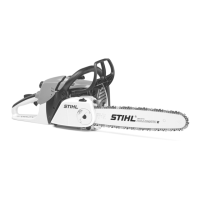MS 270, MS 270 C, MS 280, MS 280 C
English
6
Dangers of kickback
Kickback occurs when the saw is
suddenly thrown up and back in an
uncontrolled arc towards the operator.
Kickback occurs, e.g.
– when the upper quadrant of the bar
nose unintentionally contacts wood
or another solid object, e.g. when
another limb is touched accidentally
during limbing.
– when the chain at the nose of the
guide bar is pinched in the cut.
Quickstop chain brake:
This device reduces the risk of injury in
certain situations – it cannot prevent
kickback. If activated, the brake stops
the saw chain within a fraction of a
second – for a description of this device
refer to chapter on "Chain Brake" in this
manual.
To reduce the risk of kickback
– Work cautiously and avoid
situations which could cause
kickback.
– Hold the saw firmly with both hands
and maintain a secure grip.
– Always cut at full throttle.
– Be aware of the location of the guide
bar nose at all times.
– Do not cut with the bar nose.
– Take special care with small, tough
limbs, they may catch the chain.
– Never cut several limbs at once.
– Do not overreach.
– Never cut above shoulder height.
– Use extreme caution when re-
entering a previous cut.
– Do not attempt plunge cuts if you
are not experience in this cutting
technique.
– Be alert for shifting of the log or
other forces that may cause the cut
to close and pinch the chain.
– Always cut with a correctly
sharpened, properly tensioned
chain – the depth gauge setting
must not be too large.
– Use a low kickback chain and a
narrow radius guide bar.
Pull-in (A)
Pull-in occurs when the chain on the
bottom of the bar is suddenly pinched,
caught or encounters a foreign object in
the wood. The reaction of the chain pulls
the saw forward – always hold the
spiked bumper securely against the
tree or limb.
Kickback can result in
serious or fatal injury.
001BA036 KN
001BA093 LÄ
001BA037 KN
A

